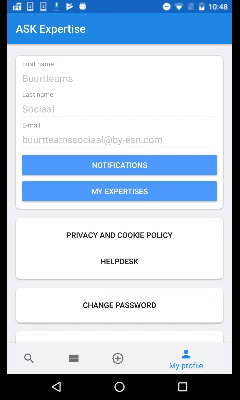为了确保错误消息在用户没有看到它的情况下可见,我将其子类化TextInputLayout并将其放置在ScrollView. 这让我可以在需要时向下滚动以显示错误消息,在每次设置错误消息时。使用它的活动/片段类不需要更改。

import androidx.core.view.postDelayed
/**
* [TextInputLayout] subclass that handles error messages properly.
*/
class SmartTextInputLayout @JvmOverloads constructor(
context: Context, attrs: AttributeSet? = null, defStyleAttr: Int = 0
) : TextInputLayout(context, attrs, defStyleAttr) {
private val scrollView by lazy(LazyThreadSafetyMode.NONE) {
findParentOfType<ScrollView>() ?: findParentOfType<NestedScrollView>()
}
private fun scrollIfNeeded() {
// Wait a bit (like 10 frames) for other UI changes to happen
scrollView?.postDelayed(160) {
scrollView?.scrollDownTo(this)
}
}
override fun setError(value: CharSequence?) {
val changed = error != value
super.setError(value)
// work around https://stackoverflow.com/q/34242902/1916449
if (value == null) isErrorEnabled = false
// work around https://stackoverflow.com/q/31047449/1916449
if (changed) scrollIfNeeded()
}
}
以下是辅助方法:
/**
* Find the closest ancestor of the given type.
*/
inline fun <reified T> View.findParentOfType(): T? {
var p = parent
while (p != null && p !is T) p = p.parent
return p as T?
}
/**
* Scroll down the minimum needed amount to show [descendant] in full. More
* precisely, reveal its bottom.
*/
fun ViewGroup.scrollDownTo(descendant: View) {
// Could use smoothScrollBy, but it sometimes over-scrolled a lot
howFarDownIs(descendant)?.let { scrollBy(0, it) }
}
/**
* Calculate how many pixels below the visible portion of this [ViewGroup] is the
* bottom of [descendant].
*
* In other words, how much you need to scroll down, to make [descendant]'s bottom
* visible.
*/
fun ViewGroup.howFarDownIs(descendant: View): Int? {
val bottom = Rect().also {
// See https://stackoverflow.com/a/36740277/1916449
descendant.getDrawingRect(it)
offsetDescendantRectToMyCoords(descendant, it)
}.bottom
return (bottom - height - scrollY).takeIf { it > 0 }
}
我还修复了 TextInputLayout.setError() 在清除同一类中的错误后留下空白空间。

